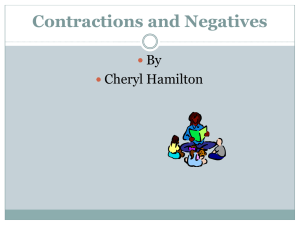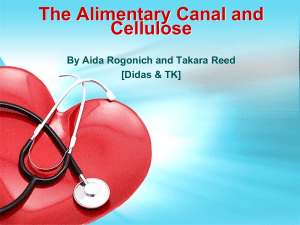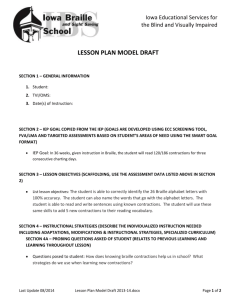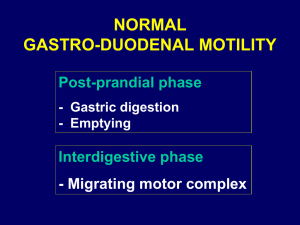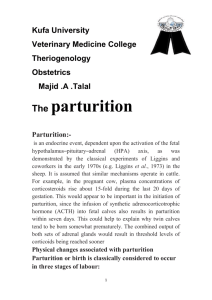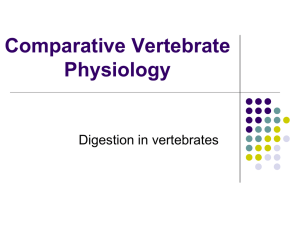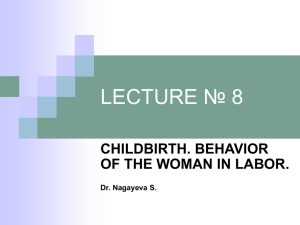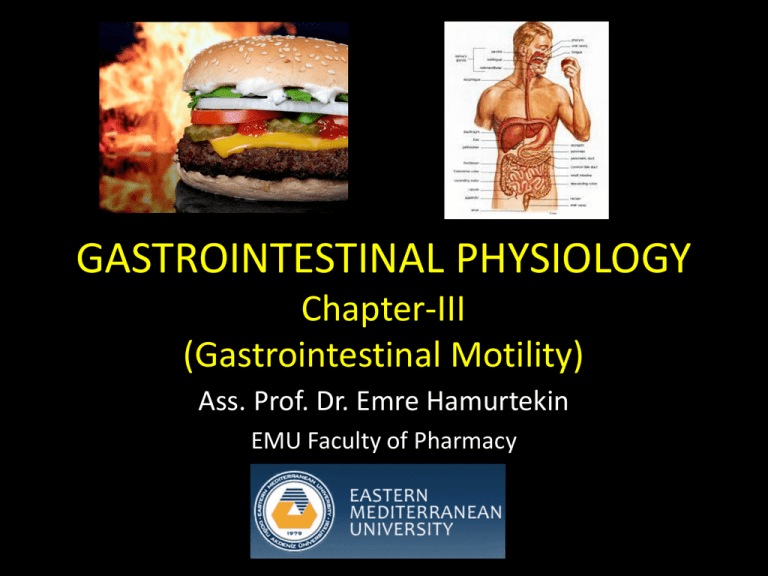
GASTROINTESTINAL PHYSIOLOGY
Chapter-III
(Gastrointestinal Motility)
Ass. Prof. Dr. Emre Hamurtekin
EMU Faculty of Pharmacy
PERISTALTIS
Peristaltis is a
reflex
response
initiated when
the gut wall is
stretched.
It occurs in all
parts of the GI
tract.
SEGMENTATION
A segment of bowel contracts at both ends and a second
contraction occurs in the center of the segment.
It is designed to retard the movement of the intestinal
contents.
It provides mixing of the intestinal contents with the
digestive juice.
BASIC ELECTRICAL ACTIVITY
The spontaneous rythmic fluctuations of the
membrane potential of the smooth muscle of GI tract
between about -65 and -45 mV is called ‘basic
electrical rhythm, BER’.
The BER itself rarely causes muscle contraction.
Spike potentials over the depolarizing portion of the
BER waves increase muscle tension.
BER coordinates peristaltic activity and setting the
rhythm of segmentation.
Ach increases the number of spikes and the tension
of the smooth muscle, but epinephrine decreases.
MIGRATING MOTOR COMPLEX
A modification in the electrical and motor activity
in smooth muscle of GI tract between periods of
digestion.
The cycles (MMC) of motor activity migrate from
the stomach to the distal ileum.
Phases of MMC:
Phase I: No spike potentials, no contractions
Phase II: Irregular spike potentials & contractions
Phase III: Regular spike potentials & contractions
The MMCs are initiated by motilin.
MOUTH & ESOPHAGUS
MASTICATION & SWALLOWING
Mastication (chewing):
Breaks up large food particles
Mixes the food with the salivary secretions
Swallowing is a reflex response triggered by
afferent impulses in,
trigeminal,
glossopharyngeal,
vagus nerve
efferent impulses in
trigeminal,
facial,
hypoglossal nerve
LOWER ESOPHAGEAL SPHINCTER
LES is tonically active
but relaxes on
swallowing.
The tone of the LES
is under neural
control.
Ach ...intrinsic
sphincter contraction
NO & VIP…....intrinsic
sphincter relaxation
STOMACH
GASTRIC MOTILITY and EMPTYING
Receptive relaxation:
Relaxation of the fundus and the upper part of the body of
the stomach to accommodate the food, when food enters
the stomach.
After receptive relaxation, peristaltis begins and mixes the
food and permits the semiliquid portions to pass through
the pylorus.
CCK and secretin stimulates the pyloric sphincter and
prevents regurgitation.
Gastric emptying rate depends on;
Type of food ingested
(carbohydrate rich > protein rich > fat rich)
Osmotic pressure of the material entering the duodenum
Hyperosmolality decreases the gastric emptying
Fats, carbohydrates and acid in the duodenum
inhibit gastric acid / pepsin secretion and gastric
motility.
CCK also can inhibit gastric emptying.
VOMITING
Some main reasons that trigger vomiting:
Irritation of the upper GI tract mucosa
Motion sickness
Emotionally charged stimuli
Chemical agents in the circulation stimulating CTZ
Chemoreceptor Trigger Zone (CTZ):
Located in the Area Postrema in the medulla
Not protected by blood-brain barrier
Includes chemoreceptor cells that can be stimulated
by certain chemical agents.
Vomiting is an example of central regulation of GI
motility.
SMALL INTESTINE
INTESTINAL MOTILITY
There are 3 types of smooth muscle contractions:
Peristaltis
Segmentation contractions
Tonic contractions
Tonic contractions are relatively prolonged
contractions that in effect isolate one segment of
the intestine from another.
Segmentation contractions
retard
Tonic contractions
transit time
COLON
COLON MOTILITY
Motility in this segment is slow.
Ileocecal valve is shut by the increases in colonic
pressure and opened increases in ileal pressure.
Gastroileal reflex:
Relaxation of cecum and increase in the passage of small
intestinal content when food leaves the stomach.
3 types of colonic smooth muscle contractions:
Peristaltic waves
Segmentation contractions
Mass action contraction*** (occurs only in the colon)
Mass action contraction:
Simultaneous contractions over large confluent areas occurs
about 10 times / day that move the material from one portion of
the colon to another.
ILEOCECAL VALVE
DEFECATION
DEFECATION
Distension of rectum with feces initiates reflex
contractions and desire to defecate.
Internal anal sphincter relaxes when the rectum is
distended.
Internal anal sphincter:
Sympathetic: excitatory
Parasympathetic: inhibitory
External anal sphincter:
Skeletal muscle
Pudendal nerve
Gastrocolic reflex:
Contractions of the rectum and desire to defecate initiated
by distention of stomach by food
THE END

